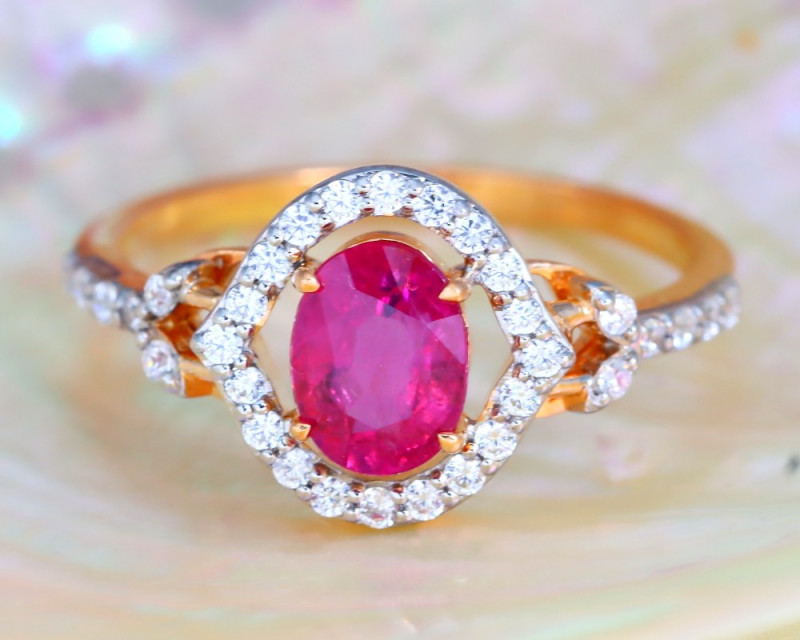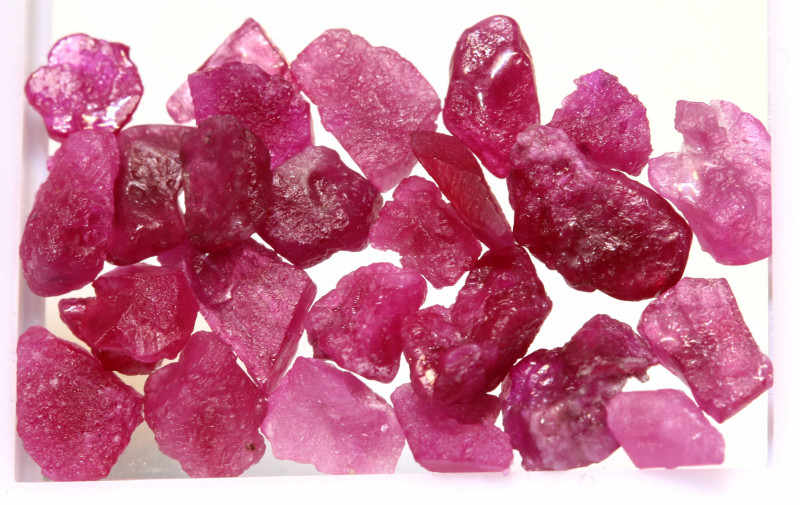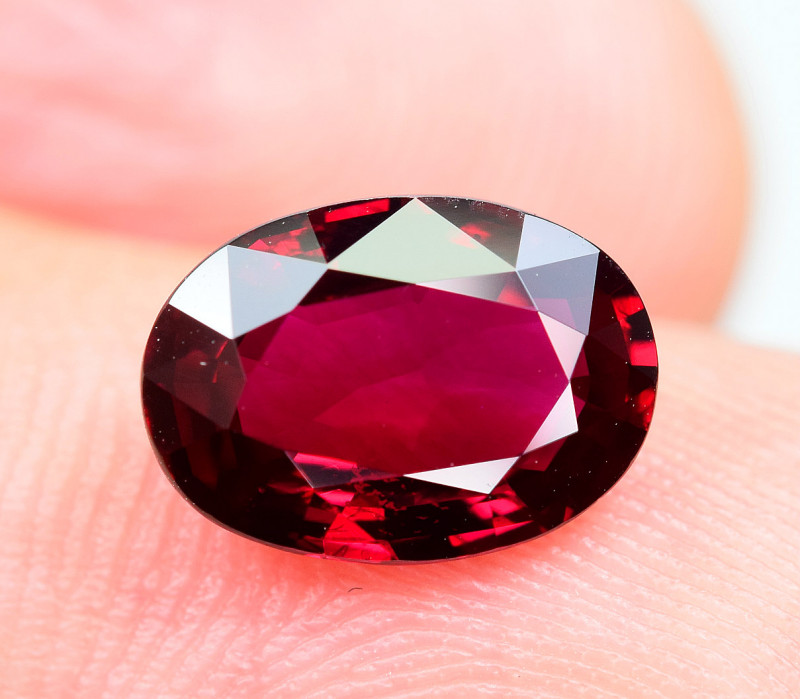
Ruby Gemstone: History, Uses, Properties & More
 When it comes to precious gemstones, nothing beats the classic ruby! This royal red jewel is treasured worldwide — it’s even made waves in modern culture and entertainment – just think of Dorothy’s iconic ruby slippers from Wizard of Oz. We know everyone loves them, but what is the ruby stone, and what can we learn about its properties, meanings, and uses?
When it comes to precious gemstones, nothing beats the classic ruby! This royal red jewel is treasured worldwide — it’s even made waves in modern culture and entertainment – just think of Dorothy’s iconic ruby slippers from Wizard of Oz. We know everyone loves them, but what is the ruby stone, and what can we learn about its properties, meanings, and uses?
It’s no secret that rubies make the perfect pendants, rings, and necklaces for sparkling red jewelry.
However, did you know that people use rubies as protective amulets and healing stones, too? What about using rubies as powerful energy crystals to help you manifest your dreams? With this glimmering gem, the sky’s the limit.
In this extensive guide, we’ll dig deep into the priceless ruby’s unique properties. With a jewel this phenomenal, we’re confident that its qualities will blow you away!
What is The Ruby Stone?
Ruby is a type of rare mineral called corundum. In fact, the only other variety of corundum is sapphire. Sapphires and rubies are ample and abundant, but they naturally have notoriety since they’re from a rare and durable mineral class.
What makes ruby even more remarkable is that it belongs to the elite cardinal gem family. Cardinal gems comprise five traditionally precious gemstones: diamonds, emeralds, sapphires, amethysts, and of course, rubies.
Thanks to their gorgeous red hues, rubies make the perfect anniversary and Valentine’s Day gifts. Popular choices include ruby stone necklaces and earrings.
Of course, rubies are just as fascinating in raw gem form. Let’s look at some essential ruby specifications.

Ruby Specifications and Characteristics
As a corundum gem, ruby is made from aluminum oxide. This powerful gem nearly tops the Mohs mineral scale of hardness at a jaw-dropping 9. That makes ruby stones tougher than both emeralds and Masonry drill bits! These jewels are both dazzling and durable, second only in hardness to diamonds.
Color: red, orange-red, purplish red, pinkish-red
Crystal structure: trigonal
Luster: subadamantine, vitreous
Transparency: transparent to translucent
Refractive index: 1.757-1.779
Cleavage: none
Aside from its stunning beauty and strength, what makes ruby gemstones such excellent choices for jewelry? The key to that question lies in its gemstone properties. Let’s check them out!
Ruby Gemstone Properties
When shopping around for gemstones, you’ve probably come across certain concepts like cut, color, clarity, and carat weight. What do these terms mean, and how can they help you find the perfect ruby jewelry?
Cut
Cutting refers to the process of shaping raw, unpolished crystals into the gems that we see on the market. When it comes to ruby stones, the most popular shapes are round and oval.
Round rubies sparkle brightly with their starry twinkle. Gem cutters often fashion them into solitaire rings, earrings, and wedding jewelry.
Oval-shaped rubies, on the other hand, are sure to turn heads with their striking red colors. Oval cuts do a great job of preserving gem material – and more material just means more value.
Other popular ruby cuts include emerald, heart, pear, and princess. For rubies that are larger than one carat, cushion shapes can nicely balance their weight.
Aside from cut, what other gemstone properties should you consider? Let’s move on to color.
Color
There are three definitions to keep in mind when it comes to gem colors: hue, saturation, and tone.
Hue refers to a gemstone’s color as we see it. For ruby, its primary hues are red. Secondary and tertiary hues can include pink, orange, or purple.
Saturation indicates color visibility, or whether a gem is light or dark. Rubies that are darker in color tend to be more valuable.
Finally, tone applies to color purity. If a ruby stone is pure-toned, it won’t have any secondary hues like orange or pink.
So, what color ruby is most valuable? The answer: rubies with strong red hues.
Clarity
When rubies form deep inside the Earth’s crust, they absorb mineral impurities and other dust and debris elements. The process results in the presence of inclusions – trapped crystal particles that can affect a gemstone’s structure and appearance.
Natural rubies will most often have visible inclusions. Common examples include silk, clouds, needles, feathers, and crystals.
Most gemstones with visible inclusions have less value. However, a jewel as rare and precious as ruby will remain priceless regardless of any inclusions — it’s that valuable.
Speaking of value, let’s see how carat weight enters the picture.
Carat Weight
When it comes to carat weight, it’s rare to find a precious gem that exceeds five carats. As a result, any high-quality gemstone that size – or even just above two or three carats – is incredibly valuable.
Because rubies are uniquely sourced, larger gems will command higher prices. Higher-quality ruby stones typically weigh one carat or less, while commercial-grade gems come in many sizes.
So, we now have a clear idea of how the four Cs can help you pick out jewelry. But what about natural vs. synthetic rubies?

Ruby Treatments
It’s pretty standard for ruby stones to receive treatments to enhance color and clarity, transforming an already dazzling stone into an exceptional jewel.
For example, lower-quality rubies often receive heat treatments to remove purplish-blue coloring and upgrade the stone’s clarity. Heating rubies to a sweltering 2400-3300 degrees Fahrenheit results in gorgeously vivid gems.
But what about synthetic rubies?
These synthetic counterparts can appear as striking as their natural counterparts, despite being grown in a lab. The process was invented in the late 19th century by French chemist Auguste Verneuil. Since then, many have adopted Verneuil’s methods to produce fine-quality synthetic rubies.
While synthetic rubies are a modern creation, rubies as a whole have been part of human history for millennia.
Ruby History
Ruby stones derive their name from the Latin word ruber, which unsurprisingly means “red.”
Ancient societies everywhere revered ruby as a symbol of wealth, power, and protection. Even the famous Roman scholar Pliny the Elder praised its hardness and density in his acclaimed work Natural History.
Rubies were highly venerated in ancient India as well. Most interestingly, they were sorted into their own caste system. “Inferior” rubies couldn’t come into contact with those in the upper castes. “True” Oriental rubies held the highest rank, called Brahmin. The ancient Indians believed that Brahmin rubies provided total protection against any sort of danger.
Speaking of protection, rubies were worn as defenses against disaster and disease. On the battlefield, soldiers bore ruby-encrusted weapons and armor for safety and victory.
So, it’s clear that ruby has always held a place of honor and glory in human civilization. Let’s now turn to its own origins and sources.

Ruby Stone Origins and Sources
Earlier, we mentioned that rubies are formed within the Earth’s crust. Certain conditions must come into play for rubies to form naturally.
One such condition is the formation of corundum, which occurs when traces of aluminum are substituted with chromium ions; this is how rubies get their iconic red colors.
Another condition that must be met is the absence of silica and iron. When these elements are present, rubies cannot form. Since silica and iron are so abundant in the Earth’s crust, it’s a miracle that rubies even exist!
Luckily, there are many ruby deposits around the world. The most famous mines prevail in Myanmar (formerly Burma).
Myanmar (Burmese) rubies cost premium prices for their rich blood-red hues, known as “pigeon’s blood.” These vividly dark gems carry the faintest traces of purple and are deeply saturated.
Other global suppliers of ruby stones include Thailand, Australia, Cambodia, Afghanistan, Brazil, India, Japan, and Colombia. Despite the odds, rubies are thriving everywhere!
While we’re on the topic of thriving, let’s explore ruby gemstone meanings and how this vibrant jewel can help you flourish.
Ruby Stone Meaning
The rich red ruby stone represents vitality and abundance. For those seeking a rejuvenated spirit or a prosperous life, consider meditating with ruby. The universe just may end up fulfilling your desires.
If love and romance seem to elude you at every turn, try looking toward ruby for guidance. As the ultimate symbol of passion, this rosy red jewel may help ignite sparks between you and a special someone!
But rubies offer far more than an arrow from Cupid!
Ruby stones have symbolized power and protection throughout the ages. With this gem by your side, you can find inner strength and avoid misfortune.
Best of all, rubies can help you discover positivity and happiness. You’ll be washed clean of any impure and negative energy, leaving behind uncontainable joy.
Ruby gemstone benefits don’t just stop there. Let’s delve into ruby’s spiritual and healing gifts next.

Ruby Spiritual and Healing Properties
In terms of our health and spiritual well-being, what are the benefits of ruby stones?
Rubies can target many physical ailments, from poor eyesight to liver disorders. On an emotional level, they can ward off depression and insecurity.
As spiritual healing stones, rubies closely relate to the chakras. These sacred energy centers correspond to certain areas of your body and promote holistic wellness.
Ruby stones have the power to activate your heart chakra, which is centered in your chest. Rubies can open up this chakra and help you evolve in love, compassion, and empathy.
What are the benefits of wearing ruby stones? By placing these gems directly on your body, especially around the chakras, you can maximize ruby’s healing potential. Close your eyes and picture that energy as a glowing force. Allow yourself to be enveloped in it, to be healed by it.
And now, with a renewed mind and spirit, let’s look into how we can best take care of our precious stones.
Ruby Care and Maintenance
The beauty of ruby (aside from its gorgeous appearance, of course) is that it doesn’t require much maintenance — one of the many perks of having a strong and sturdy gem!
For rubies with no visible inclusions and fractures, jewelry care and maintenance are especially easy. Just be sure to keep your gemstones clean, either with safe mechanical cleaners like steamers or by hand-washing.
If you own a jewel that has lots of inclusions, you’ll want to stick with the trusty soap and water method.
Grab a bowl, soft-bristled toothbrush, and mild, scent-free detergent.
Use the toothbrush to delicately scrub your jewelry, removing any dirt and grime.
Rinse your gem thoroughly and gently pat dry with a soft microfiber towel.
And you’re done! Be sure to clean as needed or about once a month. Other than that, your ruby is good to go! If you’re noticing an accumulation of buildup and grime, don’t hesitate to take your gems to a reputable jeweler for an annual or bi-annual cleaning.
Now that your jewelry is sparkling and clean, let’s go find the answer to this classic question: “Are rubies expensive?”

Ruby Stone Prices and Value
With how famous rubies are, it’s no surprise that many of us are frantically Googling prices. After all, just how much is a 1-carat ruby worth? And while we’re on the subject: are ruby stones expensive?
Ruby prices can span from $10-12,000 per carat. That’s quite the range!
Of course, these prices will vary depending on gem quality and the four Cs that we discussed above. As mentioned before, rubies from Myanmar are highly valuable.
Gem size plays a role as well. In fact, large gem-quality rubies are sometimes even more valuable than diamonds!
As you shop for ruby gems online, be sure to keep these price points and factors in mind. Whether you’re looking to splurge or save, we’re confident you’ll find a jewel that fits your style and budget!
Ready for A Red Ruby Stone of Your Own?
That leads us to the end of the road with ruby stone information, and now your ruby journey begins! From ancient history to modern times, ruby stones have been cherished worldwide for their graceful beauty and versatile qualities. And it’s easy to see why!
Born against the odds, the resilient ruby has blazed its own path as a unique gem among jewels. With their enchanting depth, durable armor, and holistic healing powers, ruby stones are sure to dazzle you daily. After all, everybody needs a little bit of ruby in their lives!
Looking to buy ruby gems? Browse our gorgeous selection of rubies today!
Search the Gemstone Encyclopedia
Related Auctions
Related Articles
Originally the Birthstones or gemstones were associated with a zodiac sign or the month of a individuals birth. Find out what your stone is and view the stones we have for sale
8th Feb 2021
There are dozens of quartz and chalcedony gems with various colors and patterns. Learn all about quartz properties and every type of quartz, from amethyst and agate to plasma and phantom quartz!
15th Oct 2020
Have you ever wondered how they treat Ruby gemstones? There are so many different types of treatments on the market and we will help to explain them
9th May 2018
Latest Articles
Stibiotantalite is a rare tantalum mineral sometimes found as stunning yellow to orange gems. Discover the history, properties, prices, and uses of stibiotantalite gemstones in this complete guide.
21st Jan 2025
Milarite is a white, green, or yellow beryllium silicate in the milarite-osumilite group. Faceted gems are rare but stunning. Discover the history, properties, prices, and benefits of milarite gems!
6th Jan 2025
Friedelite is an uncommon pink, red, or brown manganese silicate mineral best known from New Jersey and South Africa. Learn the prices, properties, uses, and history of friedelite gemstones.
23rd Dec 2024
Article Categories
How To's is where you will find helpful articles from gem Rock Auctions on how to cut gemstones, select gemstones and buy gemstones.
9 Articles





